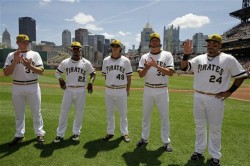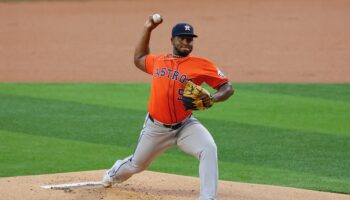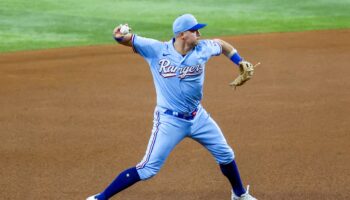
NL East: Show us some more Natitude!
The Atlanta Braves have built the biggest lead of any of the division leaders going into the second half (six games), have the best home record in the majors and have the National League’s best record vs. teams at or above .500 (27-19).
And yet, I can’t take my eyes off the Washington Nationals and think that they’re the team that should win this division.
The pitching has been just as good as it was last season, when the Nats won 98 games, but it’s the offense that has been letting the staff down. The Nats 357 runs only rank ahead of the Miami Marlins in terms of runs scored in the NL, and injuries to Bryce Harper and Danny Espinosa only complicated matters when the Nats could not support quality starts by its pitchers with some semblance of an offense. Harper is back – evidenced by his homerun on his first at-bat coming off the DL on July 1 after missing a month with a knee injury – and his effectiveness is the tone-setter for the rest of the Nationals offense. Anthony Rendon might have been called up before he was major-league ready, but the Rice University standout has given the Nats an offensive boost in Espinosa’s absence while working out the kinks playing second base. Any upswing in the offense, along with the continued pitching from both the starters and the relief pitching, and Washington should be right in the thick of things in the NL East. Only being six games back should be considered more of a blessing than anything else.
A huge seven-game homestand awaits Washington to start the second half (3 with the Dodgers, 4 vs. Pittsburgh). No time like the present for Washington to show the Natitude it did last season.
NL Central: Central Casting
The division with the most intrigue and competitive balance resides in the NL Central, with the majors two best records (St. Louis and Pittsburgh) and Cincinnati (53-42) not too far behind them. With the playoff format currently in place, there is room for all three in the playoffs, and given their first-half play, why wouldn’t all three make the postseason?
Want to know why St. Louis, probably the model franchise for consistency in baseball, has been winning despite long-term injuries to starting pitchers Chris Carpenter and Jaime Garcia? They’ve been hitting the cover off the ball with runners in scoring position (.337 BA w/RISP as a team, .328 w/RISP & 2 outs). Because of those otherworldly numbers, their run differential is plus-127, 36 more than the next best run differential total in the majors (Boston at plus-91). One player specifically, Allen Craig, should be the MVP of the NL if his hitting in those situations continues (.489 w/RISP).
The Pittsburgh Pirates should finally break their 20-year run of finishing seasons under .500. Before you jump on me about the collapse the Pirates have had the last few seasons, let me hit you with this statistic. Pittsburgh, as of July 13, was 20 games over the .500 mark. Only one team in the history of modern baseball (since 1900) finished a season below .500 after being at least 20 games over the .500 mark in that same season. The team you ask? The predecessor to the Cleveland Indians, the 1905 Cleveland Naps (named after Hall-of-Famer Nap Lajoie) finished 76-78 after being 23 games over .500 at one point in that season.

The big decision for the Pirates will be what to do at the trade deadline. The pitching staff has been so surprising – and borderline dominant – that it has maked many deficiencies in the batting order. Andrew McCutchen is the only Pirate batting over .300, and GM Neal Huntington may need to acquire a bat at the deadline to fortify the lineup. Does he risk shipping off some prospects on a team full of prospects in order for a quick rental? At the very least, it’s a good problem to have.
Cincinnati was keeping pace with St. Louis and Pittsburgh before a cold snap hit them before the break. They’re still occupying one of the wild card spots, and Great American Balllpark continues to be one of the best home field advantages in the game. They may have the most important stretch of any team in the NL to begin the second half; three vs. Pittsburgh, followed by a west coast swing and three games with the Dodgers, four with the Giants (including a doubleheader in which the teams will split being the home team), and three in San Diego. Oh, and after that, they play at home to St. Louis for three, then home to Oakland for two.
NL West: Someone has to win it…right?
If you’re an optimist, the NL West is just as competitive as any division in baseball, with four teams only separated by six games in the loss column.
On the pessimist side, the NL West is a disaster area, with only one team above .500 (the 50-45 Arizona Diamondbacks) and the team that was quickly heading for the “most disappointing” label after the first month (Los Angeles Dodgers) now becoming the favorites to win the division.
And then there are the defending champions, the San Francisco Giants, who, again, are trying to overcome long stretches of anemic offense to make a run.
As much as it is easy to dismiss the Diamondbacks, don’t forget that this was a team that won the division a couple of years ago out of the blue, and have yet to have a losing season under Kirk Gibson – even though this is only his third year. Paul Goldschmidt leads the league with 77 RBI, and that’s made more impressive by the fact that Arizona has not had a consistent lead-off hitter all season. Adam Eaton, the projected leadoff hitter coming out of spring training, strained his left elbow before the season and re-injured it during rehab. He’s finally back, and what he does at the top is key to Arizona’s long-term success – as well as the continued great pitching from starter Patrick Corbin.
What can I say about Yasiel Puig that everyone in the baseball universe hasn’t said already? The Dodgers are 24-15 since his electrifying debut on June 3 – the best record in baseball since then – and his talent and all-out play on the field has been infectious, as well as job-saving (if you believed reports of Don Mattingly’s demise earlier in the season). His play is made all the more impressive give the fact that the projected outfield (Carl Crawford, Matt Kemp and Andre Ethier) all battled, or are currently battling, injuries and inconsistency. No one expects Puig to keep up his torrid hitting (.391 BA), but I’m of the mindset of always asking the question, “What if he does keep it up?”
Different year, same story (not really) for the Giants: pitching is decent to good (nope…staff ERA is over 4), offense is bad to putrid (nope…team is third in NL in batting average), injuries mount and mount (oh, that’s still the same). The past three seasons have yielded two World Series titles, so whatever recipe the Giants whip up definitely has yielded some amazing cuisines recently. Probably the biggest encouraging sign that the Giants may be players in the second half is the no-hitter that Tim Lincecum threw in his last start in San Diego. The record and ERA (5-9, 4.26 ERA) are definitely eyesores. But a former co-worker of mine created a stat called the “domination quotient,” and pitchers in this category average over a strikeout an inning while allowing less than a hit per inning. Lincecum, with his 125 strikeouts and 107 hits allowed in 116.1 innings, doesn’t lack for dominance, and a couple of good starts after the break can help him and the Giants reclaim championship form.
With all due respect to the Rockies – who had a bright start to begin the season, – and the Padres – who are a better second-half team than first-half team under Bud Black – this is a three-horse race in the NL West.
**Click here for the American League 2nd Half outlook




